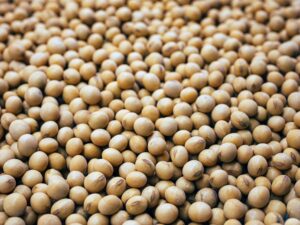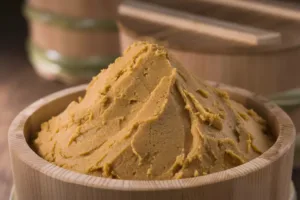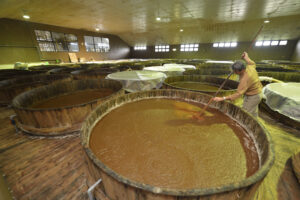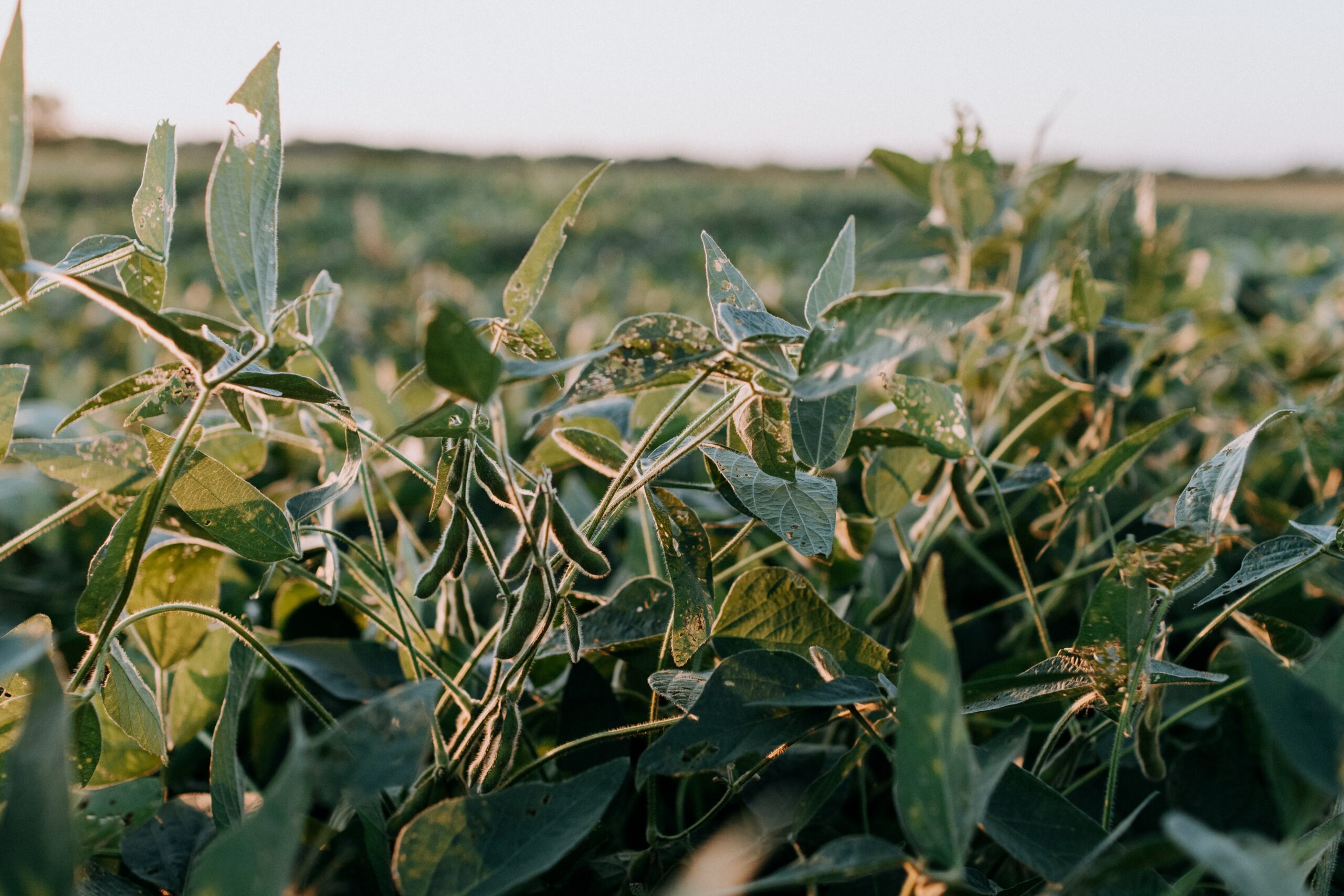Soy paste
Soy paste is basically prepared from whole or flaked soy beans and other cereals (wheat, rice, barley) that is fermented, mixed with brine and fermented again to produce a salty, tangy condiment or seasoning for meat, fish and vegetable dishes. It can also be used as a base for sauce preparation to go with meat, seafood, poultry or vegetable dishes and as a stock for soups. It can also be spiced with hot peppers (chilli) to produce “hot soy paste”.
A wide variety of soy paste products is available on the market. This is due to the different raw ingredients and methods of preparation, as family recipes were passed on from one generation to the next. Chinese soy paste (jiang) is usually prepared from whole soy beans and wheat bran, and the final product is gritty and spicy to complement their stronger flavoured cookery. Japanese soy paste (miso) is usually prepared from soy beans and rice or barley and is ground to a paste that resembles the consistency of peanut butter. It has a milder taste and a lighter colour.
Process description – Chinese soy paste preparation
The preparation of Chinese soy paste can be divided into five main steps
- Koji starter preparation
- Treatment of soy and cereals
- Inoculation and first fermentation
- Addition of brine and second fermentation
- Preservation and packaging
Preparation of koji starter
The direct translation of “koji” is “bloom of moulds”. The koji starter provides the spores of microorganisms needed to make soy paste. Its preparation is very similar to the preparation of a starter culture for yoghurt and serves the same purpose. Soy beans are firstly crushed and mixed with other cereal products in the desired ratio. Water is added to about 95% and the mixture is steam-cooked to ensure that all natural flora is destroyed. Cooking also causes breaking down of starch to components that are easier to digest for inoculum. The cooked soy cereal mix is then spread out on cooling trays and cooled to about 30° C to ensure optimum activity of the inoculum. The soy and cereal mix is inoculated with a selected strain of Aspergillus oryzae and incubated in a sterile environment under controlled conditions. Fermentation occurs at 28 to 30° C for 16 hours, followed by an increase in the temperature to 34° C for an additional 48 hours, or until green spores are visible. The mature koji is then harvested to act as a starter culture during the preparation of soy paste.

Clean whole soy beans.
Treatment of soy and cereals prior to inoculation
Whole soy beans are cleaned, soaked for three to five hours in water and drained before being steamed for 40 minutes. Cooking is a very important step that enhances protein digestibility by koji starter culture and thus ensures the desired final texture of the paste. The cooked soy beans are then cooled to 80° C prior to mixing with wheat. Wheat bran or flour is steamed or roasted before being mixed with the hot soy beans. The ratio of the soy to wheat is generally 65:35. The mixture is then allowed to cool down between 38 and 40° C prior to inoculation.
First fermentation
The treated soy and wheat mixture is inoculated with the prepared koji starter. The concentration of starter used is between 0,3 and 0,5%. Fermentation takes place on open pans under a controlled temperature of 36° C, airflow and relative humidity of more than 90%. The mixture is occasionally stirred to release internal heat generated by fermentation and to ensure sufficient aeration of the mixture. The first fermentation stage is usually completed after 30 to 36 hours when the mixture turns olive green. The resulting product is known as mature koji and is regarded as an intermediate product of soy paste and sauce manufacturing. Koji moulds contain a great variety of enzymes that digest starch, protein and lipid components of the raw material. During this fermentation process the major components of the raw materials are thus broken down to smaller components that act as substrate for the second fermentation process.
Second fermentation
The koji is now mixed with warm brine and packed in fermentation vats or tanks and allowed to ferment anaerobically. Temperature is a very important factor during fermentation. During the early stages of brine fermentation, the temperature is controlled between 42 and 45° C to encourage proteolysis. In the later stages, the temperature is elevated to between 50 and 52° C to promote amylase activity.
It takes 15 days of brine fermentation (under optimal temperature conditions) to produce the product in known as jiang. The product may be allowed to mature for an additional month at 30 to 35° C to improve the flavour.

Soy bean paste (Image source: thespruceeats.com)
Process description – Japanese soy paste preparation
The method for making Japanese soy paste products differs slightly from the Chinese method and consists of the following main steps:
- Preparation of koji starter culture
- Preparation of rice Koji
- Treatment of soy beans
- Mixing and mashing
- Fermentation
- Pasteurisation and packaging
Preparation of koji starter
This step is the same as described above for the Chinese paste.
Preparation of rice koji
Cleaned, polished rice is washed and soaked in water at 15° C overnight to increase the moisture content to about 35%. The water is then drained and the rice is steam-cooked for 40 minutes in an open cooker. The cooked rice is then cooled to 35° C. The koji starter is added to the cooled, cooked rice at a concentration level of 0,1%. The mixture is incubated at 30° C and 96% relative humidity for 15 hours. It is then spread out on large open trays in layers of four cm thick and fermentation continues at 30 to 35° C until the rice is completely covered with white mycelium. This is now referred to as mature koji.
Treatment of soy beans
The treatment of the soy beans runs concurrent with the preparation of rice koji. Cleaned whole soy beans are washed and soaked overnight. The water is drained and the soy beans are steam-cooked until tender. Cooking can be performed in a pressure cooker at 0,7 to 1 kg per cm² for 20 to 30 minutes, or in an open pan cooker for several hours. The bean to water ratio in the open cooker is usually 1:4. The cooked soybeans are transferred to a belt conveyor type cooler where it is spread out and cooled to between 25 and 30° C.
Mixing and mashing of rice koji and soy beans
The rice koji and cooked soy beans are mixed together with salt and boiled water. The mixture is inoculated by pure culture of yeast and lactic acid bacteria or miso from a previous batch (mother miso). It is roughly mashed in a chopper and forced through five millimetre perforations. The homogeneous mix is then transferred to an open vat or fermentation vat that has been disinfected. Here it is left to ferment under controlled temperatures of 30 to 38° C for at least six months. The fermented mash is blended and may be pureed even further by a plate cutter with one to two millimetre perforations.

Mixing and mashing of rice koji and soy beans (Image source: justhungry.com)
Pasteurising and preserving soy paste
Since the raw paste contains viable microorganisms, the paste is usually pasteurised in a steam-jacketed pasteuriser or preserved with chemical preservatives. Permitted preservative include ethyl alcohol (2%) and sorbic acid (0,1%)
Packaging of soy paste
Pasteurised paste may be hot-filled into containers or aseptically filled into retail containers. Suitable containers include glass jars, plastic pouches or tubs.
Labelling of soy paste
Soy paste containers are labelled with the necessary information and visuals to make it an attractive product on the market.
Literature sources:
- Applewhite, T.H. 1989. Vegetable Protein Utilization in Human Food and Animal Food Stuffs.
- Lui, KeShun. 1999. Soy beans: Chemistry, Technology and Utilization. Gaithersburg: Aspen Publishers, Inc.
- Snyder, H.E. & Kwan, T.W. 1987. Soybean Utilization.
- Tanteeratarm, K. 1992. Soybean Processing for Food Uses.
Published with the acknowledgement to the ARC Institute for Agricultural Engineering for the use of their manuals. Visit www.arc.agric.za for more information.









